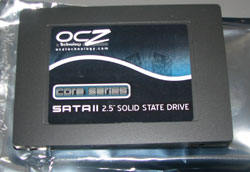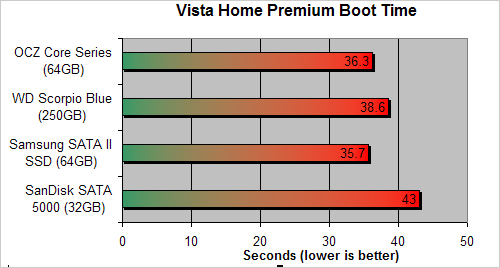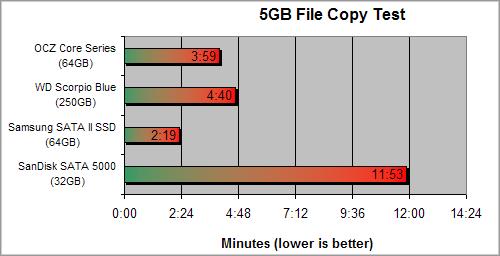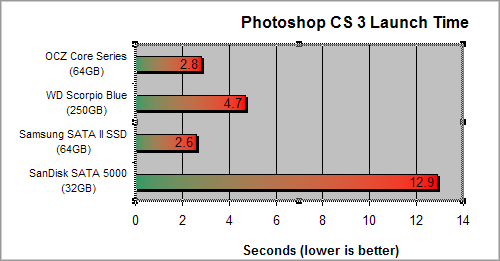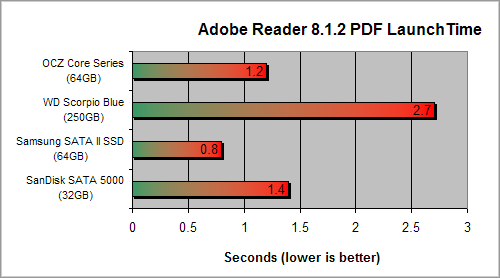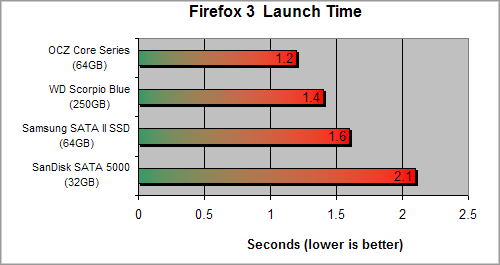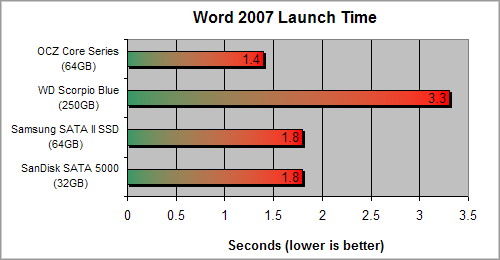OCZ Core Series Affordable SSD Hands-On
We all know that It's only a matter of time before the last mechanical hard drive whirs its way into a landfill mound, right next to a Tandy cassette drive and a giant pile of Zip disks. But we're all waiting impatiently, because SSDs still cost too much and store too little.
A couple of weeks ago, OCZ announced its Core Series, a family of low-cost, high-performance SSDs that is intended to make solid -state storage affordable for the masses. The Core Series is expected to retail for $169 (32GB), $259 (64GB), and $479 (128GB) while offering read transfer rates well over 100MBps and seek under 1ms. In a world where high-performance SSDs typically cost hundreds of dollars more -- the 64GB Samsung SATA II we've been testing retails for well over $800 -- OCZ's advertised numbers are impressive.
Today, an attractive package arrived in our office, containing an OCZ Core Series 64GB. We immediately installed the highly-anticipated hard drive in our current testbed, a Gateway T6828 with 3GB of RAM and Vista Home Premium.
While we're still running a variety of additional tests on the drive, we've seen enough to say that this drive has a lot of potential. But, without further exposition, let's go to the tests.
Synthetic Read Tests
We immediately tried read tests in Sisoft Sandra and HD Tach. Sisoft Sandra returned an impressive average read rate of 112.4MBps and a seek time of 1ms. HD Tach, which has to be run in Windows XP-compatibility mode under Vista, gave us an average read score of 89.5MBps with a seek time of .5ms. These numbers are really strong, considering that a standard 5,400rpm notebook hard drive, like the Western Digital Scorpio Blue our testbed came with, gets around 46MBps with a seek time of over 17ms in HD Tach.
OCZ's published read transfer rate for the Core Series is 120MBps and indeed, in both test benchmark programs, it occasionally hit burst speeds exceeding that number, but no drive we've ever tested in HD Tach or Sisoft Sandra has gotten the exact published spec transfer rate as an average read rate. Perhaps published transfer rates are meant to be maximums not averages. But enough of synthetic benchmarks, let's see how this thing performs in real-world applications.
Sign up to receive The Snapshot, a free special dispatch from Laptop Mag, in your inbox.
Boot Time
We measured the amount of time it took to cold boot into Windows Vista Home premium. To be as acccurate as possible, we pointed a camera at the screen and then went back and counted the amount of seconds it took from the moment our finger hit the on button to the moment the last tray icon appeared. We then compared the results to some other drives we've tested in the past with the same exact system.
It's interesting to note the very small difference in boot times between the drives we tested. Only one, the low-performance SanDisk SATA 5000, did significantly worse than the others. We think it's fair to say that boot time isn't helped a great deal by SSD, at least not in our case. The 2.3 second difference between the OCZ Core Series and our test bed's original 5,400rpm drive is almost insignificant and could be pure randomness or dumb luck.
The other thing to keep in mind about boot times is that a huge chunk of time is taken up by the BIOS's posting process. In our OCZ Core Series boot test, we noted the different stages of the boot process and that we had to wait a full 15.6 seconds before the little green Windows status bar appeared, then 17.2 more seconds for the Windows desktop to appear, and finally another 3.5 seconds for our very minimal set of tray icons to show up. This suggests that an upgrade to any SSD would do very little to speed Windows boots over a 5,400rpm hard drive. However, we're sure a painfully slow hard drive or SSD would slow down boots.
File Copy Test
To test the read/write speed of the drive, we took a folder filled with 5GB of mixed media files (images, videos, sounds, docs) and copied them from one folder on the hard drive to another. The results on the OCZ Core Series were a bit better than the default 5,400rpm Western Digital hard drive, a lot better than the embarrassingly-slow SanDisk SATA 5000, but unfortunately double the time of the Samsung SATA II.
To be fair, the Samsung SATA II is a more expensive drive, based on more costly SLC memory so we expect better write times if not better read times as well.
We also think the Western Digital drive shown here may be better than some other 5,400rpm hard drives. Just this week, for example, we tested a Thinkpad SL400 with a Hitachi 5,400rpm hard drive that gave a time of 6:36, though it was in a different system so we can't use it on our chart here. We'll be doing more file tests very soon.
Photoshop CS3 Launch Time
Here you can see a significant difference between the two high-performance SSDs and the mechanical hard drive. The old school SanDisk drive is such a slow drive, it doesn't really belong in this test, but it is an example of a previous-gen SSD.
PDF Open Time
We also took a rather large document, the 500+ page 911 Comission Report, and opened it using Adobe Reader 8.1.2 on all the drives. As you can see, all the SSDs, even the slow-going SanDisk, blew away the mechanical hard drive. We suspect that the lower seek times of all the SSDs were more important than transfer rates for this test.
Firefox 3 Launch
We tried launching Firefox to a blank Web page (loading a site would test our net connection and the server on the other end, rather than the hard drive). Since this is a fairly light application, the time differences were small.
Word 2007
Believe it or not, on a slower hard drive, it can actually take a fair amount of time to open Word 2007, even if you're just creating a new blank document. All of our drives here were fairly close, but we've seen other 5,400rpm drives on other systems that took as long as 10 seconds. In this case, the OCZ Core series delivered the best time by a tiny margin, but all the SSDs were tangibly better than the hard drive.
Future Directions
We're continuing to test the OCZ Core Series and plan to go back and run additional tests on some of the other units we still have around. Expect to see a full review from us in the days ahead, along with a discussion about whether the less-expensive MLC memory found in the Core Series is any worse in practice than the SLC type you see in $800+ drives like the Samsung SATA II.

